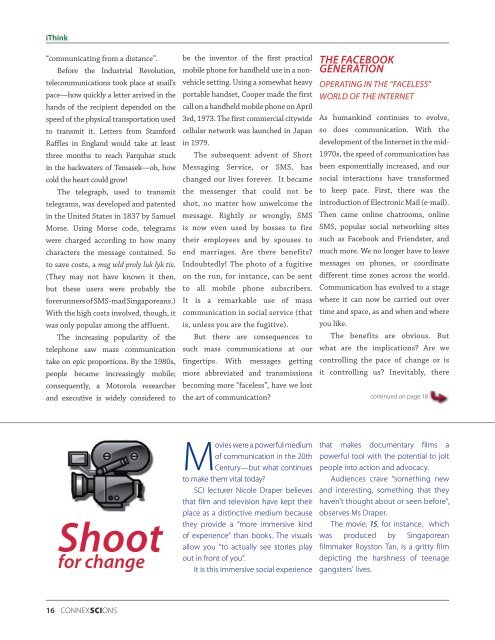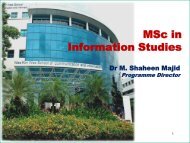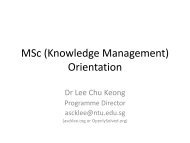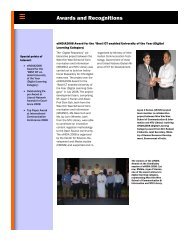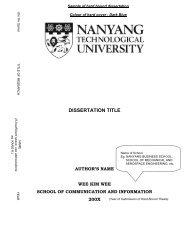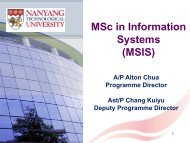CONNExSCIONS - WKWSCI Home - Nanyang Technological ...
CONNExSCIONS - WKWSCI Home - Nanyang Technological ...
CONNExSCIONS - WKWSCI Home - Nanyang Technological ...
Create successful ePaper yourself
Turn your PDF publications into a flip-book with our unique Google optimized e-Paper software.
iThink<br />
“communicating from a distance”.<br />
Before the Industrial Revolution,<br />
telecommunications took place at snail’s<br />
pace—how quickly a letter arrived in the<br />
hands of the recipient depended on the<br />
speed of the physical transportation used<br />
to transmit it. Letters from Stamford<br />
Raffles in England would take at least<br />
three months to reach Farquhar stuck<br />
in the backwaters of Temasek—oh, how<br />
cold the heart could grow!<br />
The telegraph, used to transmit<br />
telegrams, was developed and patented<br />
in the United States in 1837 by Samuel<br />
Morse. Using Morse code, telegrams<br />
were charged according to how many<br />
characters the message contained. So<br />
to save costs, a msg wld proly luk lyk tis.<br />
(They may not have known it then,<br />
but these users were probably the<br />
forerunners of SMS-mad Singaporeans.)<br />
With the high costs involved, though, it<br />
was only popular among the affluent.<br />
The increasing popularity of the<br />
telephone saw mass communication<br />
take on epic proportions. By the 1980s,<br />
people became increasingly mobile;<br />
consequently, a Motorola researcher<br />
and executive is widely considered to<br />
Shoot<br />
for change<br />
16 coNNexSCIoNs<br />
be the inventor of the first practical<br />
mobile phone for handheld use in a nonvehicle<br />
setting. Using a somewhat heavy<br />
portable handset, Cooper made the first<br />
call on a handheld mobile phone on April<br />
3rd, 1973. The first commercial citywide<br />
cellular network was launched in Japan<br />
in 1979.<br />
The subsequent advent of Short<br />
Messaging Service, or SMS, has<br />
changed our lives forever. It became<br />
the messenger that could not be<br />
shot, no matter how unwelcome the<br />
message. Rightly or wrongly, SMS<br />
is now even used by bosses to fire<br />
their employees and by spouses to<br />
end marriages. Are there benefits?<br />
Indoubtedly! The photo of a fugitive<br />
on the run, for instance, can be sent<br />
to all mobile phone subscribers.<br />
It is a remarkable use of mass<br />
communication in social service (that<br />
is, unless you are the fugitive).<br />
But there are consequences to<br />
such mass communications at our<br />
fingertips. With messages getting<br />
more abbreviated and transmissions<br />
becoming more “faceless”, have we lost<br />
the art of communication?<br />
movies were a powerful medium<br />
of communication in the 20th<br />
century—but what continues<br />
to make them vital today?<br />
scI lecturer Nicole draper believes<br />
that film and television have kept their<br />
place as a distinctive medium because<br />
they provide a “more immersive kind<br />
of experience” than books. The visuals<br />
allow you “to actually see stories play<br />
out in front of you”.<br />
It is this immersive social experience<br />
THE fAcEbOOk<br />
GENERATION<br />
operating in the “faCeless”<br />
world of the internet<br />
As humankind continues to evolve,<br />
so does communication. With the<br />
development of the Internet in the mid-<br />
1970s, the speed of communication has<br />
been exponentially increased, and our<br />
social interactions have transformed<br />
to keep pace. First, there was the<br />
introduction of Electronic Mail (e-mail).<br />
Then came online chatrooms, online<br />
SMS, popular social networking sites<br />
such as Facebook and Friendster, and<br />
much more. We no longer have to leave<br />
messages on phones, or coordinate<br />
different time zones across the world.<br />
Communication has evolved to a stage<br />
where it can now be carried out over<br />
time and space, as and when and where<br />
you like.<br />
The benefits are obvious. But<br />
what are the implications? Are we<br />
controlling the pace of change or is<br />
it controlling us? Inevitably, there<br />
continued on page 18<br />
that makes documentary films a<br />
powerful tool with the potential to jolt<br />
people into action and advocacy.<br />
audiences crave “something new<br />
and interesting, something that they<br />
haven’t thought about or seen before”,<br />
observes ms draper.<br />
The movie, 15, for instance, which<br />
was produced by singaporean<br />
filmmaker royston Tan, is a gritty film<br />
depicting the harshness of teenage<br />
gangsters’ lives.


